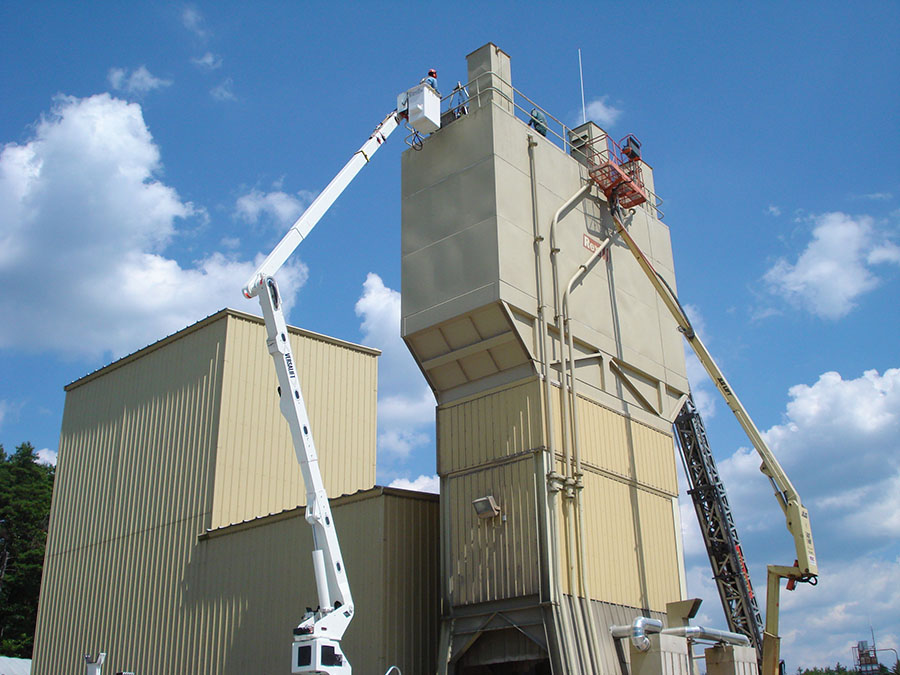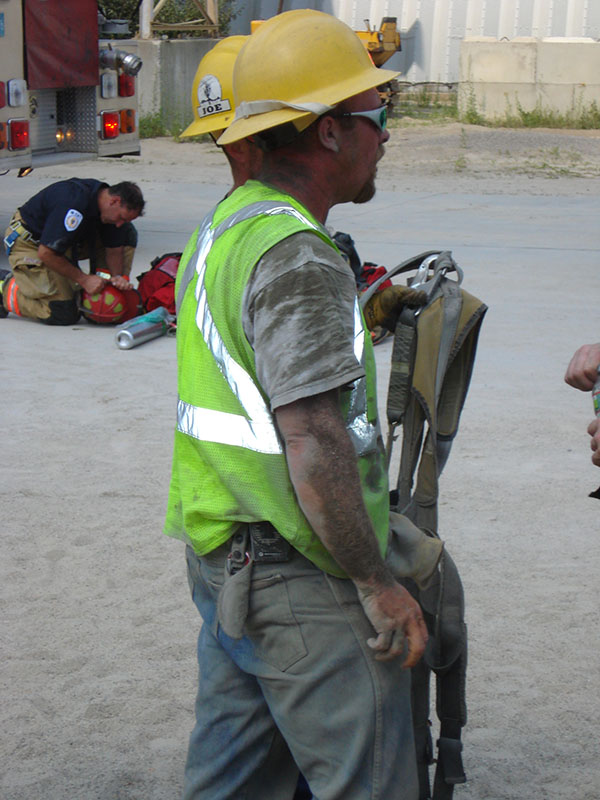 me breathing.
me breathing. On June 12 of last year Barry Tupper from Holden Municipal Light Department was working with his crew in Holden, MA, when around 2 p.m. they heard a call on their radio that a man was stuck in a silo at a local concrete company just down the road. Barry and his crew arrived at the scene to offer their assistance. It was at that time they found out the man was stuck in the silo with concrete dust caving in around him, and while the victim was conscious, he was having an extremely difficult ti me breathing.
me breathing.
The only way to reach the victim was a through a manhole-sized hatch approximately 75 feet up on the top of the silo, and the only access to the hatch was a small ladder on the outside of the silo. Holden Light called for their new tree truck, which had approximately a 75-foot working height, to assist in bringing the equipment and manpower to the top of the silo.
It was at this time that the Holden Fire Chief, Jack Chandler, who was also on site, asked Barry if he would help. According to Barry, "the chief asked if I would be willing, based on my training of self-contained breathing apparatus, confined space rescue and search and rescue and my knowledge of the equipment that we were providing if I would be willing to enter the space and assist in the rescue."
Barry gladly helped and proceeded to the top of the silo with the confined space equipment. Once he reached the top, he was informed that a paramedic had already made entrance into the silo and was in the process of locating the victim. Barry and the others set up the equipment, tripod and fall protection while the other paramedic was making his exit from the silo. The paramedic told Barry where he believed the victim to be, and that he had dropped a life line down to him and was attempting to get him oxygen when the paramedic ran out of air.
Barry proceeded into the silo and started climbing down an internal ladder that was approximately 30 feet long. After reaching the bottom of this ladder Barry realized he had to go down further and he called for Holden’s manhole ladder to continue his descent into the cement dust. Unfortunately, he was unable to make visual contact with the victim based on the fact that there was zero visibility with the dust. Barry then lowered a hand light down into the center of the "cone-like funnel of dust," to see if he could make visual contact. It was at this time he saw the light move, which indicated that he had found the victim and he was still conscious.
Barry continued to make his way down the cone of dust while having the safety personnel up top make tension on his life line to make sure that he wouldn't slide any deeper down into the silo. He made contact with the victim and checked his status. He was conscious and alert, and having trouble breathing and buried up to his chin with concrete dust. He was wedged in a very small chute close to the bottom of the silo, with tons of concrete dust collapsing around him. The dust had already gotten to his chin and was continuing to cover him with every movement. Barry assisted by giving him oxygen and then called to the personnel up top for another life line to attach to him and prevent him from falling any further down. Once the life line was attached and he was secure, they called to the incident command and requested that a hole be cut in the side of the silo to relieve some of the pressure. Using his arms and legs, Barry began to dig out some of the dust around the victim to relieve some of the pressure. Barry uncovered the victim to below the waist and instructed him to use his arms and legs to try and crawl out.
About this time Barry’s alert went off in his mask informing him that he was running out of air. Once the safety crew up top heard this they immediately began cranking him out of the silo using the fall protection tripod. At this time, Barry grabbed hold of the victim attempting to use the mechanical assist of the fall protection to pull him out. Once he had been lifted far enough out that he could no longer hold the victim, he released the victim and told him he would return to continue to dig him out. Once Barry had been removed from the silo and cleared the hatch the victim called up saying he was free and was ready to be pulled out.
 David Chapin, Lieutenant and EMT, instructed the personnel on top of the silo, which included fire, police, the Holden Municipal Light Department and DPW to begin to pull the victim out. Once the victim was clear of the hatch he was secured to a backboard, lowered down from the silo and rushed to the hospital. After a lengthy stay in the hospital, recovering from chemical burns to his mouth and throat, he was discharged and is presently back at work.
David Chapin, Lieutenant and EMT, instructed the personnel on top of the silo, which included fire, police, the Holden Municipal Light Department and DPW to begin to pull the victim out. Once the victim was clear of the hatch he was secured to a backboard, lowered down from the silo and rushed to the hospital. After a lengthy stay in the hospital, recovering from chemical burns to his mouth and throat, he was discharged and is presently back at work.
Barry has said "this rescue would not have been possible without the combined efforts of the departments of the town of Holden and the training and equipment that we have received through our line of work."
Barry Tupper joined the Holden Light Department in 1994 and became a truck foreman in 2006. He joined the fire department in 1992 and became an EMT shortly thereafter. He also became a lieutenant in the fire department in 2005.

